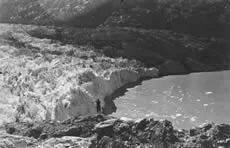Cryosphere glossary
a mass of ice resting on rock and surrounded either by an ice shelf, or partly by an ice shelf and partly by sea; no rock is exposed and there may be none above sea level; ice rises often have a dome-shaped surface; the largest known is about 100 kilometers (62 miles) across.
the formation of discrete layers or lenses of segregated ice in freezing mineral or organic soils, as a result of the migration (and subsequent freezing) of pore water.
a dome-shaped mass of glacier ice that covers surrounding terrain and is greater than 50,000 square kilometers (12 million acres) (e.g., the Greenland and Antarctic ice sheets).
from the point of view of the submariner, thin places in the ice canopy, usually less than 1 meter (3.3 feet) thick and appearing from below as relatively light, translucent patches in dark surroundings; the under-surface of an ice skylight is normally flat; ice skylights are called large if big enough for a submarine to attempt to surface through them (120 meters, 131 yards), or small if not.
(1) a current of ice in an ice sheet or ice cap that flows faster than the surrounding ice (2) sometimes refers to the confluent sections of a branched-valley glacier (3) obsolete synonym of valley glaciers.
an ice cliff forming the seaward margin of an inland ice sheet, ice piedmont or ice rise; the rock basement may be at or below sea level.
narrow ice mass that is 3 to 4 meters (10 to 13 feet) wide at the ground surface, and extends as much as 10 meters (33 feet) down; a decrease in temperature during the winter leads to ice wedge cracks in the ground around ice wedges; during the summer, these cracks accumulate melt-water and sediment, forming pseudomorphs.
an oligochaete worm that lives on temperate glaciers or perennial snow; there are several species that range in color from yellowish-brown to reddish-brown or black; they are usually less than 1 millimeter (0.04 inch) in diameter and average about 3 millimeters (0.1 inch) long; some eat red algae.
ice-bearing permafrost in which the soil particles are cemented together by ice.
topography that is due almost solely to differences in the amount of excess ice underlying its surface.
the temperature at which ice first forms during freezing of a soil/water system that does not initially contain ice.
a piece of ice that has broken off from the end of a glacier that terminates in water.
Image

Lamplugh Glacier, in Glacier Bay Alaska, shows the terminus of a typical tidewater glacier. The terminus of the glacier is heavily crevassed and jagged, and is calving small icebergs. For scale, note the man standing on the rocks in the foreground (near the center of the photograph). This photograph was taken in 1941.
W. O. Field, archived at the World Data Center for Glaciology, Boulder, CO